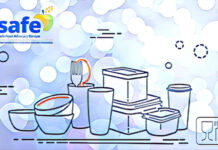Nonstick pans raise some health concerns, but they are regularly used in cooking. The French consumer monthly magazine 60 Millions de Consommateurs evaluated 9 with Teflon-type or ceramic coatings and 5 with iron or steel coatings to measure the migration of chemicals into food. (1)
Nonstick pans, the PFOA nightmare
Teflon’s most feared chemical compound is perfluorooctanoic acid (PFOA), until recently regularly used in the manufacturing process of nonstick pans (as well as in textiles and paints). This is a material that is effective in making surfaces impermeable to water and grease, but it is damned harmful.
After decades of use, it has been recognized as hazardous to health and the environment, where it accumulates with no way out. In the United States, a 20-year legal battle ended in 2019 with the manufacturer DuPont being ordered to pay multimillion-dollar damages for causing serious illness. (2)
Suspicious substitutes
PFOA is classified by the International Agency for Research on Cancer (IARC) as Class 2B (possibly carcinogenic to humans). It increases the risk of kidney and testicular cancer and cardiovascular disease, can alter fetal development and weaken the immune system.
Scientific evidence and growing consumer attention have convinced the industry to abandon it (encouraged by the EFSA opinion of 4.7.20) and replace it with other perfluoroalkyl substances (PFAS). However, which in turn are suspected of harming health and the environment.
The test on nonstick pans
To test whether dangerous PFOA was indeed from nonstick pans on the market, experts from 60 Millions de Consommateurs have:
– lightly abraded the coating of nonstick pans to simulate an age of use of about 10 weeks,
– Put ‘used’ pans in contact with food products.
The coatings were then analyzed, to check for contaminants such as perfluorinated compounds (e.g., PFOA) and metals.
The result
At the end of the test, three nonstick pans were found to be contaminated with small amounts of PFOA. These are the samples of:
– Sitram (2.3 ng/kg),
– Lagostina Salvaspazio (2.17 ng/kg),
– Essentiel B (1.36 ng/kg).
The detected concentrations are minimal, thus included within the allowable tolerance margin for accidental contamination. And yet-ironically, or rather, deception-the 3 contaminated samples are precisely the ones that decry the absence of PFOA.
Cocktail effect
The cocktail effect-with unknown toxicity profiles-was detected in 2 of the 3 products mentioned above, which in fact release other perfluorinated compounds.
Essential B pan detects for PFHxA migration (1.1 ng/kg). That Sitram releases as many as two substances, PFHxS (1.95 ng/kg) and PFOSA (3.4 ng/kg), to the food. The latter-subject to ongoing evaluation as a toxic and persistent substance-was also found in the Tefal Ingenio frying pan (1.85 ng/kg) and the Matfer brand ceramic-coated frying pan (7.92 ng/kg).
Unique to the sample, Buyer Choc yields 1.13 mg/kg of aluminum to the food, compared to a threshold of 5 mg/kg.
Steel, stainless is better
All 5 steel pans without nonstick coating release iron to varying degrees. Lagostina Academia (2.5 mg/kg), Beka (2.9 mg/kg), Tefal Inox (2.4 mg/kg), Mathon (1.6 mg/kg).
Very high is the migration of iron from the De Buyer Mineral B pan, the only one made of non-stainless steel, which yields as much as 526 mg/kg to the food, almost double the established threshold (280 mg).
Nonstick even if made of steel
In the test of food adherence in cooking, steel pans score very well. The best performance is by Mathon and Beka. Slightly less bright is the performance of Tefal Inox and De Buyer Mineral B. Poorly, on the other hand, is the Lagostina Academia, where the crêpe dough sticks on 7 percent of the surface.
To improve the nonstick performance of steel pans, remember, it is useful to subject the new utensil to a very simple treatment. Pour in some oil, bring it to the smoking point, throw it away, and wipe the pan dry.
One year later
Nonstickness is almost total in pans with ad hoc coating. Less performing is Essentiel B, which is difficult to find in Italy.
With abrasion simulating prolonged use over a year, three pans lose steam: Mafter, Lagostina Salvaspazio, and Essentiel B. By contrast, Green Chef, Healty & Tasty, and Sitram pans retain their initial properties. Instead, those with ceramic coating, Matfer and Tefal Asteroid, come out badly.
Marta Strinati
Notes
(1) Amine Meslem. Poêles antiadhésives. Sont-elles sûres? 60 Millions de Consommateurs, April 2022. https://www.60millions-mag.com
(2) For a reconstruction of the facts see the interview with lawyer Robert Bilot, author of the class action, published in Altreconomia on 1.12.17. https://altreconomia.it/bilott-pfas/
Professional journalist since January 1995, he has worked for newspapers (Il Messaggero, Paese Sera, La Stampa) and periodicals (NumeroUno, Il Salvagente). She is the author of journalistic surveys on food, she has published the book "Reading labels to know what we eat".







